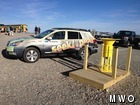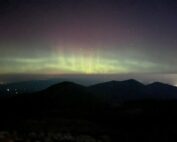Out With The Old, In With The New
2013-10-08 16:51:46.000 – Samuel Hewitt, Summit Intern
New Precipitation Can Stand!
Every six hours here on the summit, an observer ventures outside to collect the precipitation can. Once inside, a specially incremented ruler is used to determine how much precipitation has fallen over those six hours. When frozen precipitation is in the can (i.e. snow or ice pellets) it is first measured, before being melted in order to determine its liquid water equivalent.
At the Observatory, we use a standard rain gauge to measure precipitation. An 8-inch diameter aluminum cylinder, which stands 24 inches tall, is placed inside a custom stand to keep it upright. During the winter, a taller gauge (about 33 inches) is used in order to handle our heavy snowfall events. The standard rain gauge is commonly found at most National Weather Service offices as well as other human-operated stations.
Other types of gauges include the tipping-bucket and weighing rain gauges. The weighing gauge can be found at most automated surface observing stations, usually located within the vicinity of an airport. A large cylinder rests on a scale, which measures the weight of the accumulated water. The device sends a signal to a computer, which can trace a chart to determine the intensity of the precipitation throughout the day. The gauge is extremely sensitive and would not fare well in the extreme weather conditions we see here at the summit!
The time came this summer for us to replace and make some modifications to our old precipitation can stand. We are very lucky here at the Observatory to have so many friends and volunteers to give us a hand with some of our unusual needs. J.R. Higgins Associates is one of these great volunteers. After coming up on a cold rainy day a few months ago, we were provided with some amazing high tech computer designs of our future stand. We were able to view 3D drawings, make modifications, and design a stand that would be perfect for the summit during all seasons. Last week, the final product was installed at the summit, and we couldn’t be happier!
Samuel Hewitt, Summit Intern
Inside the Weather Room: How Mount Washington Observers Monitor the Atmosphere
Inside the Weather Room: How Mount Washington Observers Monitor the Atmosphere By Karl Philippoff As a weather observer on Mount Washington, we take our hourly observations on the observation deck, usually heading out between
From Weather Observer to Intern, to Observer Again
From Weather Observer to Intern, to Observer Again By Madelynn Smith As I rode in the backseat of our Obs van up the Auto Road for the first time as a full-time employee at
From Mountains to More Mountains
From Mountains to More Mountains: This Time with Stronger Winds By Alyssa Bélanger On the observation deck in high winds. Hello there! My name is Alyssa Bélanger and I am a fall






